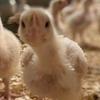Chicken Vocalizations

- A rooster's crow
- A hen's "food call" Alarm calls
- A hen's post laying "cackle" A chick's distress call
- A hen's gakel call

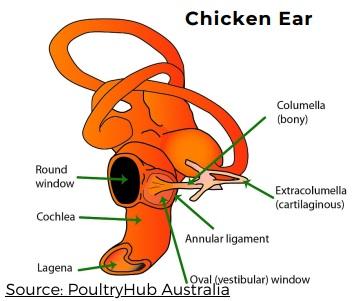
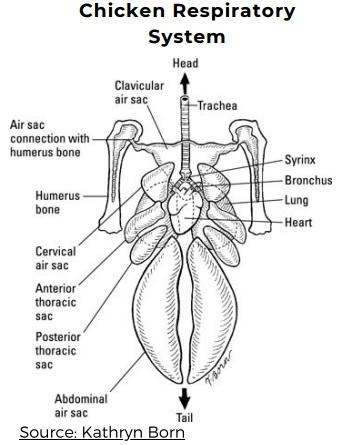
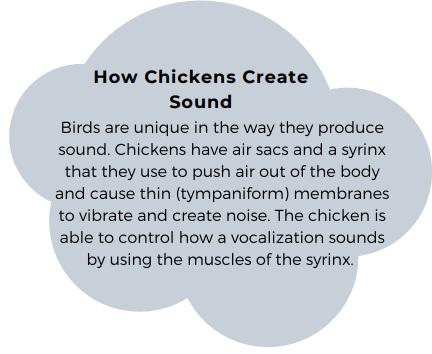
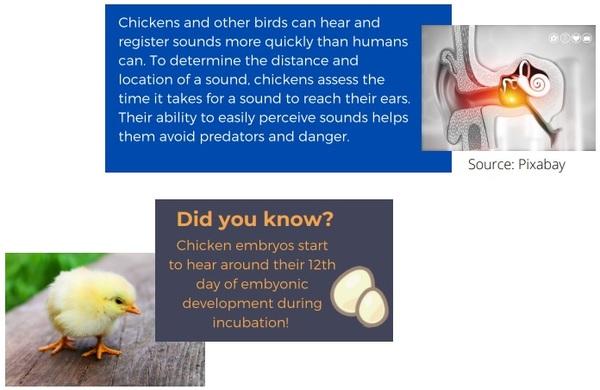
- After hatching, chicks are typically very explorative and open to learning from their mother. This is known as the imprinting phase. Mother hens are known to make "food calls", which are auditory clues to help chicks learn which foods are safe to eat.
- “Calling sounds” and “distress calls” are often seen in very young broiler chicks when isolated or stressed.
- Chickens are social animals and they operate in ways that protect the entire flock. Alarm calls are used to keep everyone safe and aware of danger. See how they work below!
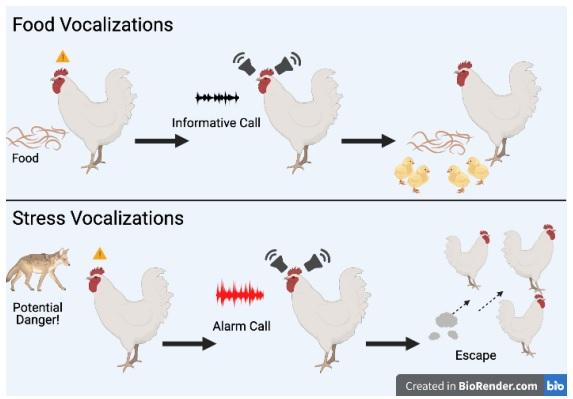
- Roosters often “crow” to show that they are dominant over other chickens or to indicate safety for the flock. They can also give alarm calls when there are potential predators nearby.
- Hens emit pre-lay vocalizations before entering a nest to lay eggs. In feral hens specifically, the pre-lay call has also been seen to attract males that are attempting to breed.
- Hens are also known to give a post-laying “cackle” after laying eggs. This is a unique collection of short vocalizations followed by an elongated one. It is believed that the purpose of this post-laying vocalization is to inform males that the hen is less likely to be receptive of fertilization at that time.
- Hens often give a gakel call to indicate frustration with their environment. This is a common response to changes in food availability. It is often associated with frustration behaviors such as stereotyped pacing or displacement preening.
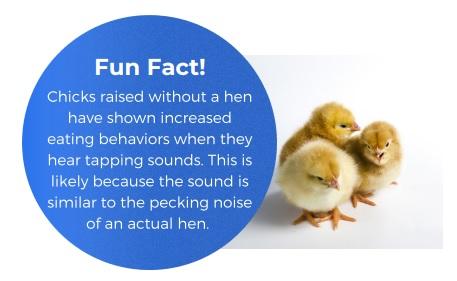
- Food calls, crowing, and calling sounds are normal vocalizations heard in flocks. They are often associated with species-specific behavior that is commonly observed in chickens.
- Monitoring the amount of distress calling heard in a backyard flock or commercial house can be a good way to bring fear behavior (running away from stressors, alerting of potential predators, etc) to ones attention.
- Changes in behavior are often indicative of changes in health or welfare. Regular monitoring of flock vocalizations could help one notice any significant vocalization changes and then investigate other potential changes in flock behavior.
Agrocota (Director). (2019, June 26). Mother hen calling her chicks to eat - agrokota.gr [Video file]. Retrieved March, 2021, from https://www.youtube.com/watch?v=aQ22wHMKk8E
Fontana, I., Tullo, E., Scrase, A., & Butterworth, A. (2016). Vocalisation sound pattern identification in young broiler chickens. Animal, 10(9). doi:10.1017/s1751731115001408
Harvey, C. (Director). (2009, March 22). Hawk alert by Rooster [Video file]. Retrieved March, 2021, from https://www.youtube.com/watch?v=FLku5KnPvqo
Herborn, K. A., McElligott, A. G., Mitchell, M. A., Sandilands, V., Bradshaw, B., & Asher, L. (2020). Spectral entropy of early-life distress calls as an iceberg indicator of chicken welfare. Journal of The Royal Society Interface, 17(167). doi:10.1098/rsif.2020.0086
Jacob, J., Dr. (n.d.). How well can poultry hear? Retrieved March, 2021, from https://poultry.extension.org/articles/poultry-anatomy/how-well-can-poultry-hear/
Jacob, J., Dr. (n.d.). Vocalization of chickens in small and backyard poultry flocks. Retrieved March, 2021, from https://poultry.extension.org/articles/poultry-behavior/vocalization-ofchickens-in-small-and-backyard-poultry-flocks/
O'Connor, K. (2021, March 25). The genetically modified chicken: How we have altered 'broiler' chickens for profit. Retrieved March, 2021, from https://www.onegreenplanet.org/animalsandnature/the-genetically-modified-chicken-how-wehave-altered-broiler-chickens-for-profit/
Otu-Nyarko,, E. (2011). The Effect of stress on the vocalizations of captive poultry populations (Doctoral dissertation, University of Connecticut,, 2010) (pp. 22-35). Ann Arbor, MI: ProQuest.
Saunders, S. S., & Salvi, R. J. (1993). Psychoacoustics of normal adult chickens: Thresholds and temporal integration. The Journal of the Acoustical Society of America, 94(1), 83-90. doi:10.1121/1.406945
Science World (Ed.). (2020, June 23). Sound. Retrieved March, 2021, from https://www.scienceworld.ca/resource/sound/
Sharp, D., Dr. (2019, August 30). What is sound? Retrieved March, 2021, from https://www.open.edu/openlearn/science-maths-technology/science/physics-andastronomy/physics/what-sound
Zimmerman P H, Lundberg A, Keeling L J, Koene P. (2003). The effect of an audience on the gakel-call and other frustration behaviours in the laying hen (Gallus gallus domesticus). Animal Welfare.






United States


